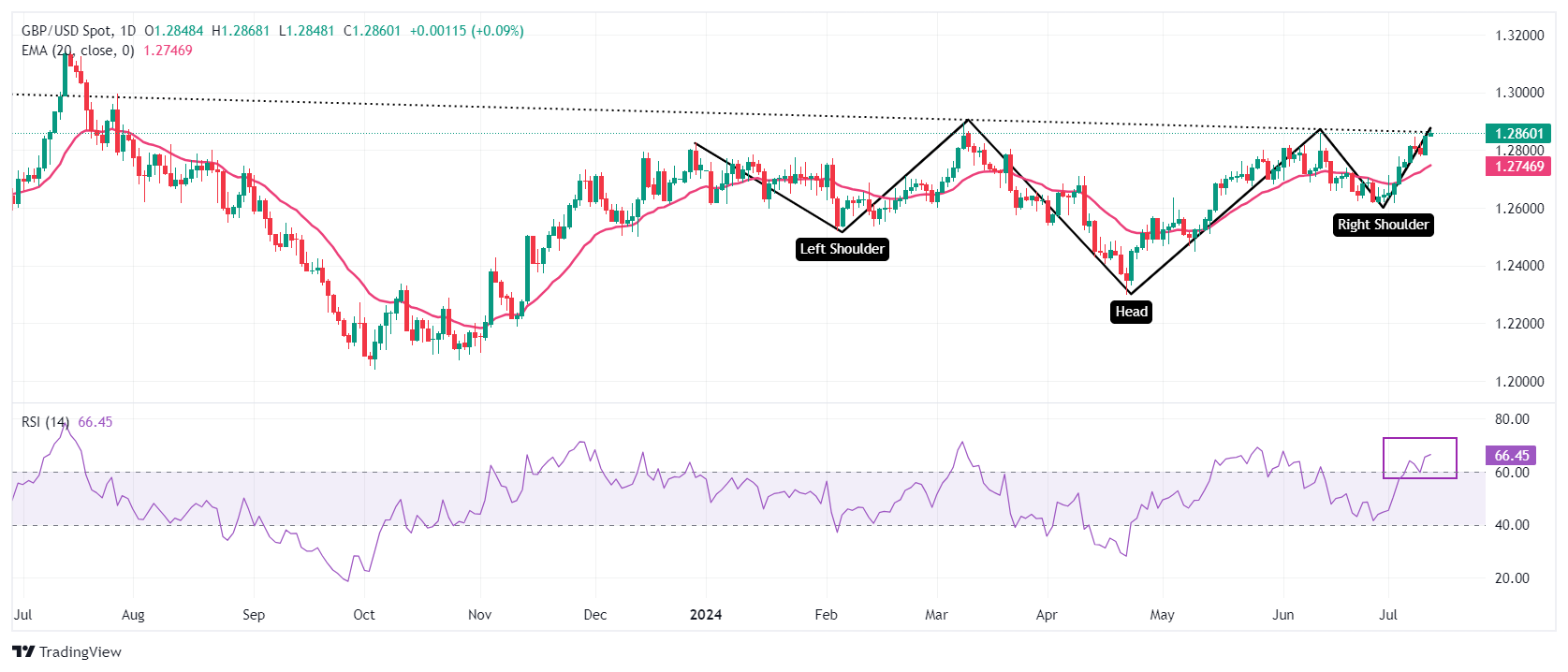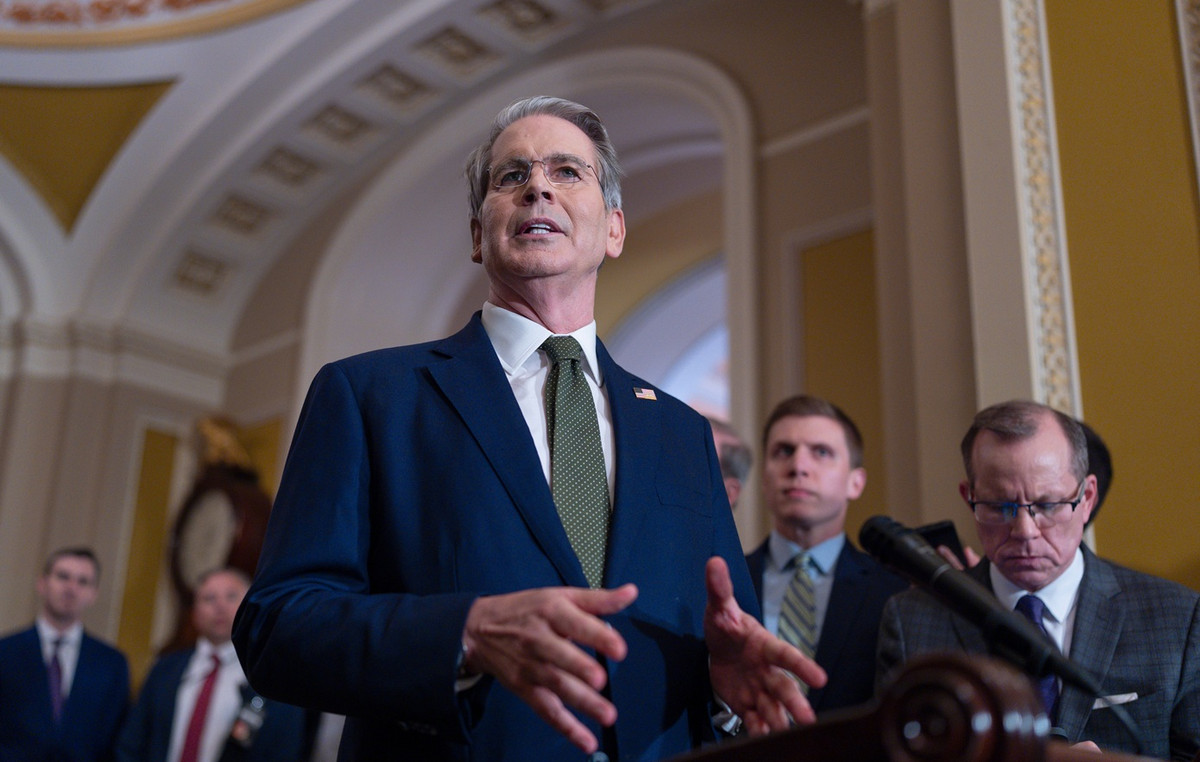- The British Pound is performing strongly against the US Dollar and other currencies due to rapid UK GDP growth and a decline in BoE rate cut prospects.
- The UK economy expanded at a faster pace of 0.4% in May, beating an estimate of 0.2%.
- Investors are awaiting US inflation data for further guidance on the Fed’s interest rate path.
The British Pound (GBP) is up near 1.2870 and nearing the year-high against the US Dollar (USD) in Thursday’s London session. The GBP/USD pair is gaining strength on the back of multiple tailwinds, including US Dollar weakness on firm speculation that the Federal Reserve (Fed) will start cutting interest rates in September and an upbeat outlook for the British currency amid easing bets on an early rate cut from the Bank of England (BoE) and a strong UK Gross Domestic Product (GDP) report for May.
The US Dollar Index (DXY), which tracks the value of the greenback against six major currencies, is down after failing to extend the recovery above the immediate resistance of 105.20.
The dollar is under pressure as Fed Chairman Jerome Powell noted some progress on disinflation in his semi-annual testimony remarks before Congress. Powell stopped short of declaring a victory on inflation but assured that policymakers are very focused on the path to price stability.
In Thursday’s session, investors will be closely watching the United States (US) Consumer Price Index (CPI) for June, which will provide clues on market expectations for Fed rate cuts in September. Economists expect core inflation, which excludes volatile food and energy items, to have grown steadily by 0.2% and 3.4% on a monthly and annual basis, respectively. Annual headline inflation is estimated to have slowed to 3.1% from May’s reading of 3.3%, while the monthly figure is expected to have grown by 0.1% after remaining unchanged earlier.
Daily Market Wrap: British Pound Outperforms US Dollar Ahead of US Inflation
- The British Pound outperformed its major peers on Thursday as the UK economy grew at a faster pace in May and BoE policymakers maintained a hawkish stance. The UK Office for National Statistics (ONS) has reported that the economy expanded strongly by 0.4% from estimates of 0.2% and a stagnant performance recorded in April.
- The UK ONS also showed that monthly Industrial and Manufacturing Production grew in line with expectations after contracting in April, while annual figures missed estimates. Monthly Industrial and Manufacturing Production rose by 0.2% and 0.4% respectively. Annually, Industrial and Manufacturing Production grew at a slower pace of 0.4% and 0.6% respectively. Factory data has returned to a positive trajectory after contracting at a stronger pace in April, suggesting a strong recovery in domestic and overall demand for factory products.
- Meanwhile, Bank of England (BoE) policymakers have pushed back expectations for rate cuts in August. On Wednesday, BoE policymaker Catherine Mann warned that the fall in annual headline inflation to the 2% target was merely a “touch and go.” Mann added that price pressures could rise again and remain above the required rate for the rest of the year. She indicated that her stance would remain hawkish until she sees a sustained decline in services inflation and wage growth.
- This week, BoE policymaker Jonathan Haskel also maintained a hawkish stance on interest rates due to persistent wage growth. Haskel said: “I would prefer to hold rates until there is more certainty that underlying inflation pressures have eased sustainably,” Reuters reported.
Technical Analysis: British Pound near 52-week high near 1.2870
The British Pound is approaching a fresh yearly high against the US Dollar near 1.2870. The GBP/USD pair is expected to extend its uptrend as it is on the verge of a breakout of the inverted Head-and-Shoulders (H&S) pattern. The neckline of the mentioned chart pattern is drawn near 1.2850, and a breakout of the H&S formation results in a bullish reversal.
The upward sloping 20-day exponential moving average (EMA) near 1.2747 suggests that the short-term trend is bullish.
The 14-day Relative Strength Index (RSI) settled in the bullish range of 60.00-80.00, indicating that momentum has tilted to the upside.
The British Pound FAQs
The Pound Sterling (GBP) is the oldest currency in the world (886 AD) and the official currency of the United Kingdom. It is the fourth most traded currency unit in the world, accounting for 12% of all transactions and an average of $630 billion a day, as of 2022.
Its key currency pairs are GBP/USD, also known as the “Cable,” which accounts for 11% of the forex market, GBP/JPY, or the “Dragon” as it is known to traders (3%), and EUR/GBP (2%). The British Pound is issued by the Bank of England (BoE).
The most important factor influencing the value of the British Pound is the monetary policy decided by the Bank of England. The Bank of England bases its decisions on achieving its main objective of “price stability”, i.e. a stable inflation rate of around 2%. Its main tool for achieving this is the adjustment of interest rates.
When inflation is too high, the Bank of England tries to contain it by raising interest rates, making credit more expensive for individuals and businesses. This is generally positive for the GBP, as higher interest rates make the UK a more attractive place for global investors to park their money.
When inflation is too low, it is a sign that economic growth is slowing. In this scenario, the BoE will consider lowering interest rates to make credit cheaper, so that companies borrow more to invest in growth-generating projects.
The data released gauges the health of the economy and can influence the value of the Pound. Indicators such as GDP, manufacturing and services PMIs, and employment can influence the direction of the Pound.
A strong economy is good for the British Pound. Not only does it attract more foreign investment, but it may encourage the Bank of England to raise interest rates, which will directly strengthen the British Pound. Conversely, if economic data is weak, the British Pound is likely to fall.
Another significant indicator for the pound is the trade balance. This indicator measures the difference between what a country earns from its exports and what it spends on imports during a given period.
If a country produces highly sought-after exports, its currency will benefit exclusively from the additional demand created by foreign buyers who wish to purchase these goods. Therefore, a positive net trade balance strengthens a currency and vice versa for a negative balance.
Source: Fx Street
I am Joshua Winder, a senior-level journalist and editor at World Stock Market. I specialize in covering news related to the stock market and economic trends. With more than 8 years of experience in this field, I have become an expert in financial reporting.








